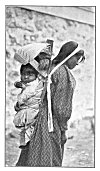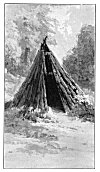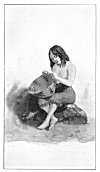
Sacred Texts Native American California Index Previous Next


Click to enlarge
YOSEMITE MOTHER AND PAPOOSE.
The baby basket is carried on the back, like all burdens, and supported by a band across the forehead.
Photograph by Boysen.
As stated in a previous chapter, all of the Indian tribes occupying the region in the vicinity of the Yosemite Valley were more or less affiliated by blood and intermarriage, and resembled each other in their customs, characteristics and religious beliefs. What is said, therefore, on these subjects in the following pages, will be understood to apply generally to all of the tribes which have been mentioned as inhabiting this region, although, of course, minor differences did exist, principally due to environment. As in the case of all primitive peoples, their mode of life, food supply, etc., were largely determined by natural conditions, and the tribes living in the warm foot-hills differed somewhat in these respects from those dwelling higher in the mountains.
In their original tribal settlements, at the time the first pioneer whites came among them, the Indians had well defined or under
stood boundary lines, between the territories claimed by each tribe for their exclusive use in hunting game and gathering means of support; and any trespassing on the domain of others was likely to cause trouble. This arrangement, however, did not apply to the higher ranges of the Sierras, which were considered common hunting ground.
As there was a difference in the natural products and resources of different sections of the country, there was a system of reciprocal trade in the exchange of the different desirable commodities. Sometimes commerce between tribes extended for a long distance, as, for instance, the Indians on the western side of the Sierra Nevada Mountains were entirely dependent upon the Pai-utes (Pye-yutes') on the eastern side for the obsidian, a kind of volcanic glass, from which they made the points for their most deadly arrows, used in hunting large game or when in mortal combat with their enemies. They were also dependent upon the Pai-utes for their supply of salt for domestic use, which came in solid blocks as
quarried from salt mines, said to be two days' travel on foot from Mono Lake.
From the Indians at or near the Catholic Missions to the South, on the Pacific Coast, they got their hunting knives of iron or steel. and sea shells of various kinds, for personal or dress ornaments, and also to be used as money. From the same source they obtained beads of various forms, sizes and colors, cheap jewelry and other fancy articles, a few blankets, and pieces of red bunting, strips of which the chiefs and head men wore around their heads as badges, indicating their official positions.
They had a very efficient system of quickly spreading important news by relays of special couriers, who took the news to the first stations or tribes in different directions, where others took the verbal dispatches and ran to the next station, and so on, so that all tribes within an area of a hundred miles would get the good or bad tidings within a few hours. In this manner important communication was kept up between the different tribes.
They also had well organized signal systems, by fires in the night and smoke by day, on high points of observation-variations in the lights (either steady, bright or flashing) indicating somewhat the character of the tidings thus given.
Their winter huts, or o'-chums, as they termed them, were invariably of a conical form, made with small poles, and covered with the bark of the incense cedar (Libocedrus decurrens). A few poles ten or twelve feet long were set in the ground around an area of about twelve feet in diameter, with their -tops inclined together. The outside was then closely covered with long strips of the cedar bark, making it perfectly watertight. An opening was left on the south side for an entrance, which could be readily closed with a portable door. An opening was also left at the top for the escape of the smoke, a fire being kindled in the center inside.
One of these huts would hold a family of a half-dozen persons, with all their household property, dogs included; and there is

Click to enlarge
INDIAN O'-CHUM.
This style of house, made of cedar poles covered with bark, is more easily heated than any other form of dwelling known.
Drawing by Jorgensen.
no other form of a single-room dwelling that can be kept warm and comfortable in cold weather with so little fire, as this Indian o'-chum.
Their under-bedding usually consisted of the skins of bears, deer, antelope or elk, and the top covering was a blanket or robe made of the skins of small fur-bearing animals, such as rabbits, hares, wildcats and foxes. The skins were cut in narrow strips, which were loosely twisted so as to bring the fur entirely around on the outside, and then woven into a warp of strong twine made of the fine, tough, fibrous bark of a variety of milkweed (Asclepias speciosa). These fur robes were very warm, and were also used as wraps when traveling in cold weather.
During the warm summer season they generally lived outside in brush arbors, and used their o'-chums as storage places.
Their clothing was very simple and scant, before being initiated into the use of -a more ample and complete style of covering while living at the reservations. The ordinary full complement of dress for a man (Nung'-ah)

Click to enlarge
YOSEMITE MAIDEN IN NATIVE DRESS.
This buckskin costume has now been replaced by the unpicturesque calico of civilization.
Drawing by Jorgensen.
was simply a breech-clout, or short hip-skirt made of skins; that for a woman (O'-hoh) was a skirt reaching from the waist to the knees, made of dressed deer-skin finished at the bottom with a slit fringe, and sometimes decorated with various fancy ornaments. Both men and women frequently wore moccasins made of dressed deer or elk skin. Young children generally went entirely nude.
The Indians of the various tribes in this part of the Sierras vary somewhat in physical characteristics, but in general are of medium height, strong, lean and agile, and the men are usually fine specimens of manhood. They are rather light in color, but frequently rub their bodies with some kind of oil, which gives the flesh a much redder and more glossy appearance. The hair is black and straight, and the eyes are black and deep set. The beard is sparse, and in former times was not allowed to grow at all, each hair being pulled out with a rude kind of tweezers. They are naturally of a gentle and friendly disposition, but their
experience with the white race has made them distant and uncommunicative to strangers.
Most of the older Indians still cling to their old customs and manner of living, and are very slow to learn or talk our language, but the younger ones are striving to live like the white people, and seem proud to adopt our style of dress and manner of cooking. They all speak our language plainly, and some few of them attend the public schools when living near by, and acquire very readily the common rudiments of an education.
Their style of architecture is in a state of transition, like themselves. Their old o'-chum form of dwelling is now very seldom seen--a rude building of more roomy and modern design having taken its place.
All the able-bodied men are ready and willing to work at any kind of common labor, when they have an opportunity, and have learned to want nearly the same amount of pay as a white man for the same work.
As a rule, they are trustworthy, and when confidence is placed in their honesty it is very rarely betrayed. During nearly the
past fifty years, a great many thousands of people have visited the Yosemite Valley with their own camping outfits, and, during the day, and often all night, are absent on distant trips of observation, with no one left in charge of camp, yet there has never to my knowledge been an instance of anything being stolen or molested by Indians. There are, however, some dishonest Indians, who will steal from their own people, and some times, when a long distance from their own camp, they may steal from the whites. A few, if they can get whisky, through the aid of some white person, will become drunk and fight among themselves, and occasionally one of them may be killed; but, as a rule, they are peaceful and orderly, and hold sacred the promise made to the Indian Commissioners by the old tribal chiefs, when released from confinement on the reservations, that they would forever keep the peace, and never again make war against the white people.